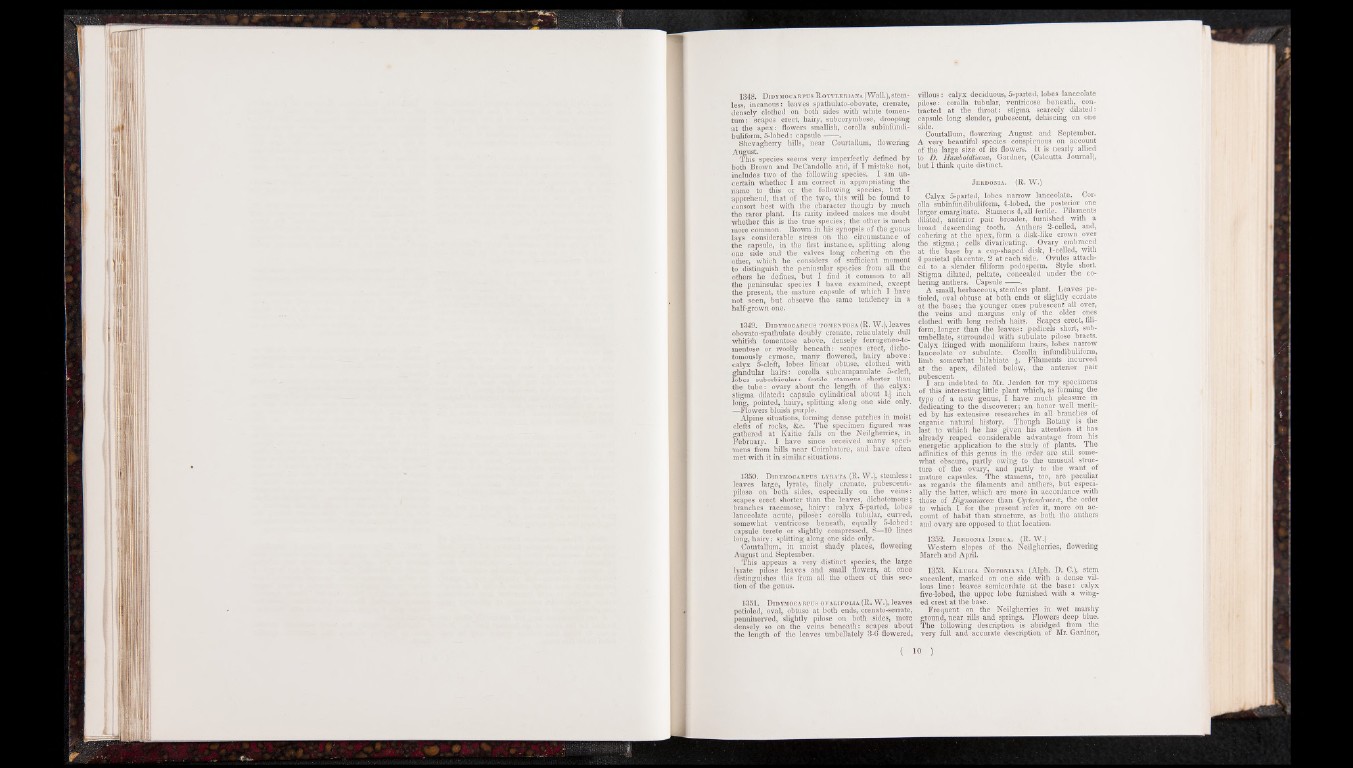
1348. Didymocarpus R ottleriana (Wall.), stemless,
incanous: leaves spathulato-obovate, crenate,
densely clothed on both sides with white tomen-
tum: scapes erect, hairy, subcorymbose, drooping
at the apex: flowers smallish, corolla subinfundi-
buliform, 5-lobed: capsule -------.
Shevagherry hills, near Courtallum, flowering
August.
This species seems very imperfectly defined by
both Brown and DeCandolle and, if I mistake not,
includes two of the following species. I am uncertain
whether I am correct in appropriating the
name to this or the following species, but I
apprehend, that of the two, this will be found to
consort best with the character though by much
the rarer plant. Its rarity indeed makes me doubt
whether this is the true species; the other ms much
more common. Brown in his synopsis of the genus
lays considerable stress on the circumstance of
the capsule, in the first instance,. splitting along
one side and the valves long cohering on the
other, which he considers of sufficient moment
to distinguish the peninsular species from all the
others he defines, but I find it common to all
the peninsular species I have examined, except
the present, the mature capsule of which I have
not seen, but observe the same tendency in a
half-grown one.
1349. Didymocarpus tomentosa (R. W.), leaves
obovato-spathulate doubly crenate, reticulately dull
whitish tomentose above, densely ferrugeneo-to-
mentose or woolly beneath: scapes erect, dicho-
tomously cymose, many flowered, hairy above:
calyx 5-cleft, lobes linear obtuse, clothed with
glandular hairs: corolla subcampanulate 5-cleft,
lobes suborbicular: fertile stamens shorter than
the tube: ovary about the length of the calyx:
stigma dilated: capsule cylindrical about 1^ inch
long, pointed, hairy, splitting along one side only.
—Flowers bluish purple.
Alpine situations, forming dense patches in moist
clefts of rocks, &c. The specimen figured was
gathered at Kaitie falls on the Neilgnerries, in
February. I have since received many specimens
from hills near Coimbatore, and have often
met with it in similar situations.
1350. Didymocarpus lyrata (R. W.), stemless:
leaves large, lyrate, finely crenate, pubescenti-
pilose on both sides, especially on the veins:
scapes erect shorter than the leaves, dichotomous;
branches racemose, hairy: calyx 5-parted, lobes
lanceolate acute, pilose: corolla tubular, curved,
somewhat ventricose beneath, equally 5-lobed:
capsule terete or slightly compressed, 8—10 lines
long, hairy; splitting along one side only.
Courtallum, in moist shady places, flowering
August and September.
This appears a very distinct species, the large
lyrate pilose leaves and small flowers, at once
distinguishes this from all the others of this section
of the genus.
1351. Didymocarpus ovaiifolia (R. W.), leaves
petioled, oval, obtuse at both ends, crenato-serrate,
penninerved, slightly pilose on both sides, more
densely so on the veins beneath: scapes about
the length of the leaves umbellately 3-6 flowered,
villous: calyx deciduous, 5-parted, lobes lanceolate
pilose: corolla tubular, ventricose beneath, contracted
at the throat: stigma scarcely dilated:
capsule long slender, pubescent, dehiscing on one
side.
Courtallum, flowering August and September.
A very beautiful species conspicuous on account
of the large size of its flowers. It is nearly allied
to D. Humboldtiana, Gardner, (Calcutta Journal),
but I think quite distinct.
Jerdonia. (R. W.)
Calyx 5-parted, lobes narrow lanceolate. Corolla
subinfundibuliform, 4-lobed, the posterior one
larger emarginate. Stamens 4, all fertile. Filaments
dilated, anterior pair broader, furnished with a
broad descending tooth. Anthers 2-celled, and,
cohering at the apex, form a disk-like crown over
the stigma; cells divaricating. Ovary embraced
at the base by a cup-shaped disk, 1-celled, with
4 parietal placentae, 2 at each side. Ovules attached
to a slender filiform podosperm. Style short.
Stigma dilated, peltate, concealed under the cohering
anthers. Capsule ——. ■
A small, herbaceous, stemless plant. Leaves petioled,
oval obtuse at both ends or slightly cordate
at the base; the younger ones pubescent all over,
the veins and margins only of the older ones
clothed with long redish hairs. Scapes erect, filiform,
longer than the leaves: pedicels short, sub-
umbellate, surrounded with subulate pilose bracts.
Calyx fringed with moniliform hairs, lobes narrow
lanceolate or subulate. Corolla infundibuliform,
limb somewhat bilabiate £. Filaments incurved
at the apex, dilated below, the anterior pair
pubescent.
I am indebted to Mr. Jerdon for my specimens
of this interesting little plant which, as forming the
type of a new genus, I have much pleasure in
dedicating to the discoverer; an honor well merited
by his extensive researches in all branches of
organic natural, history. Though Botany is the
last to which he has given his attention it has
already reaped considerable advantage from his
energetic application to the study of plants. The
affinities of this genus in the order are still somewhat
obscure, partly owing to the unusual structure
of tiie ovary, and partly to the want of
mature capsules. The stamens, too, are peculiar
as regards the filaments and anthers, but especially
the latter, which are more in accordance with
those of Bignoniacea than Cyrtandraceai, the order
to which I for the present refer it, more on account
of habit than structure, as both the anthers
and ovary are opposed to that location.
1352. Jerdonia Indica. (R. W.) _
Western slopes of the Neilgherries, flowering
March and April.
1353. Klugia N otoniana (Alph. D. C.), stem
succulent, marked on one side with a dense villous
line: leaves semicordate at the base: calyx
five-lobed, the upper lobe furnished with a winged
crest at the base.
Frequent on the Neilgherries in wet marshy
ground, near rills and springs. Flowers deep blue.
The following description is abridged from the
very full and accurate description of Mr. Gardner,